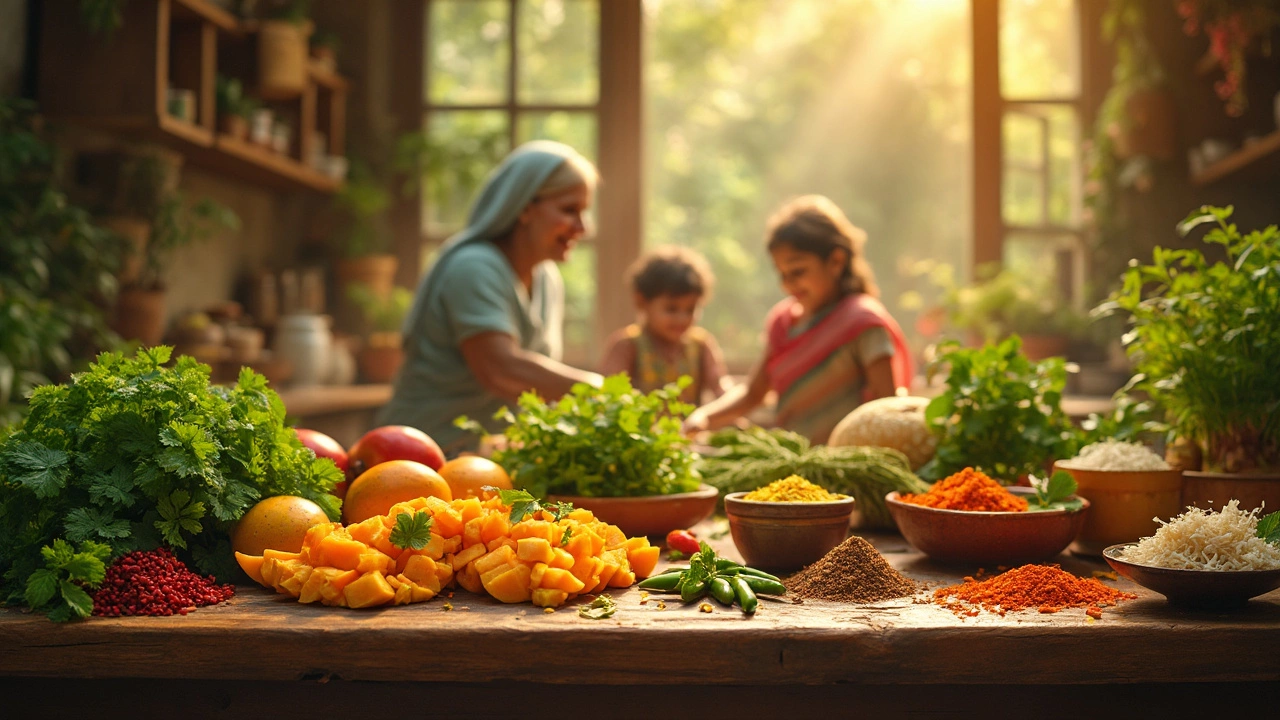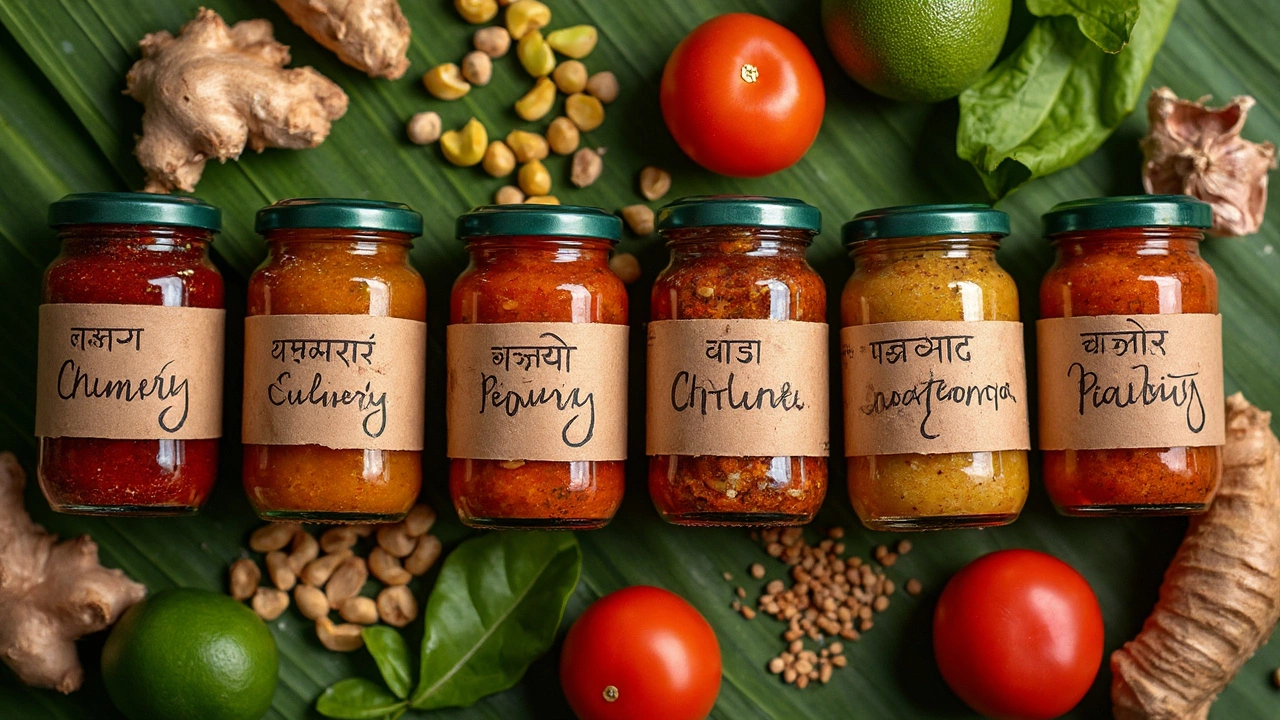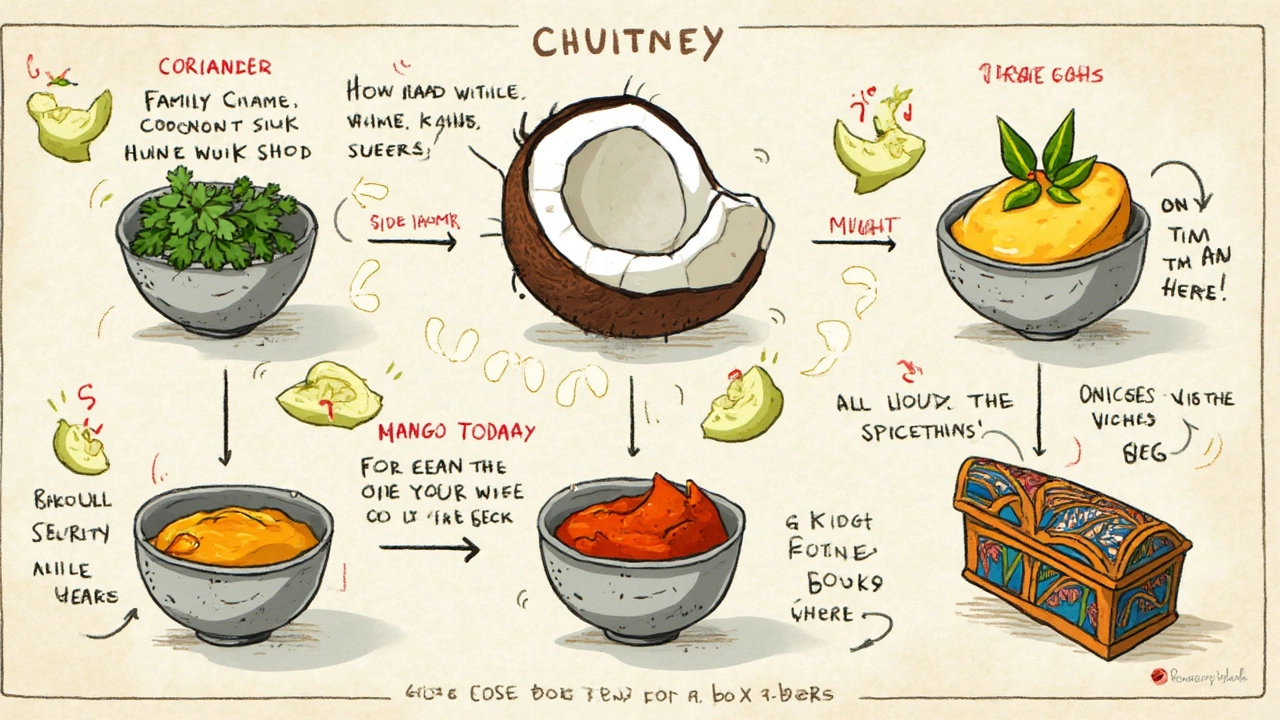Traditional Chutney: What Is It Really Made Of?
 May, 7 2025
May, 7 2025
First things first—traditional chutney isn’t one recipe. Walk into anyone’s kitchen in India, and you’ll find chutney that tastes totally different from what’s in their neighbor’s fridge. At its core, though, chutney always relies on a bold mix: fresh herbs, fruit or veggies, and a sharp touch of spice or sourness. That combo gives it the punchy flavor everyone craves.
You’ll usually spot key players like coriander, mint, or even coconut. Tamarind pulp, lemon juice, or unripe mangos bring the tang. Salt and green chilies are never far behind. Want more bite? Toss in ginger or garlic. You absolutely can experiment, but this basic setup gives you most of the variety found across traditional recipes.
- The Backbone: Everyday Ingredients
- Regional Twists and Secret Add-Ins
- How Chutney Gets Its Tang and Kick
- Fresh vs. Cooked: What Changes?
- Tips for Making Chutney at Home
The Backbone: Everyday Ingredients
Alright, back to basics—every traditional chutney you’ve tasted starts with some must-have ingredients. You won’t need a trip to fancy markets. Most things live right in your kitchen or at the corner veggie shop. The power players? Fresh herbs, a sour agent, some heat, and a little salt. Sounds simple, but these set the stage for all the twists and drama that come later.
Green chutney, the real MVP at street food stalls, is loaded with fresh coriander leaves and a bit of mint. This gives the chutney that bright punch. Want the South Indian twist? Coconut and roasted chana dal take the spotlight in coconut chutney. For Indian chutney that’s tangy and sharp, tamarind pulp or raw mango shows up to the party. Don’t forget salt and chilies—they're the backbone of taste and heat.
Here’s what usually goes in many homemade chutney types:
- Coriander Leaves: Brings color and a zesty, fresh flavor.
- Mint Leaves: Adds cooling notes, especially in green chutney recipes.
- Coconut: Used in South Indian styles for texture and mellow sweetness.
- Tamarind or Raw Mango: For that distinct tang you taste in popular chutney recipes.
- Green Chilies: The go-to for heat, but you can swap these to your spice level.
- Salt: Basic, but makes every other flavor pop.
- Ginger or Garlic: Adds depth and a little bite. Not always used, but hard to beat in some family recipes.
Most families toss everything in a blender or stone grinder, add just enough water to pull it all together, and adjust salt or tang at the last second. There’s room to personalize, but these basics are the start of any legendary chutney that lands perfectly beside a plate of samosas or hot idlis.
Regional Twists and Secret Add-Ins
This is where things get seriously interesting with traditional chutney. Every region has its own flair, and sometimes, even every family in that region throws in something special. In South India, coconut rules. Classic coconut chutney gets blended with roasted chana dal, green chilies, and a tempering of mustard seeds and curry leaves. Head to Bengal, and they’ll serve you tomato-khajur (date) chutney, which is sweet, tangy, and loaded with jaggery. Gujarati chutneys are famous for being both sweet and spicy at the same time—think fresh coriander-mint with a dash of sugar or even raw mango with saunth (dried ginger powder).
North Indian plates often have that punchy green chutney—coriander, mint, green chilies, lemon juice, and sometimes a little yogurt for creaminess. In Maharashtra, peanut chutney is a must for breakfast dishes, while Andhra Pradesh is all about fiery tomato or red chili chutneys that can set your mouth on fire.
Families also have those weird little tricks up their sleeves. Some swear by adding roasted cumin for that smoky note. Others drop in pomegranate seeds (anardana) or even a handful of nuts for texture. My wife Kavya’s family tosses a few fried urad dal bits in their coconut chutney, and trust me, that crunch totally changes the game.
- Indian chutney often features secret ingredients like a spoonful of ghee, a sprinkle of asafoetida (hing), or even grated raw turmeric during winter.
- Some older recipes call for banana peel, apple skin, or even bottle gourd when herbs run low—to avoid waste and bring in new flavors.
- Homemade chutney in Goa often uses vinegar instead of lemon, and might include cashews or raisins for extra richness.
| Region | Special Ingredient | Typical Pairing |
|---|---|---|
| South India | Coconut, Curry Leaves | Idli, Dosa |
| Bengal | Jaggery, Dates | Fried Snacks, Rice |
| Maharashtra | Peanut, Garlic | Vada Pav, Poha |
| Gujarat | Mango, Coriander | Dhokla, Thepla |
So next time you’re making a chutney recipe, think about these local twists or try tossing in something unusual from your own pantry. There’s hardly any wrong way to mix it up.

How Chutney Gets Its Tang and Kick
When people talk about traditional chutney, two things come to mind: that sharp tang and a punchy kick. It’s not by accident. The magic is all about making your taste buds wake up. So, what’s really giving chutney that hit?
For tang, most home cooks reach for some tried-and-tested regulars. Tamarind pulp leads the pack—just a spoonful adds a sour note that’s instantly recognizable. Unripe mango (kachcha aam) is the second favorite, especially in summer. You can also see lemon juice, raw tomatoes, or even vinegar cropping up in family recipes.
The heat, or “kick,” comes from a totally different set of ingredients. Green chilies are classic, but red chili powder or black pepper sometimes step in. Ginger and garlic aren’t just background flavors—they crank up that spicy surprise too.
Here’s a quick breakdown of common ingredients that bring chutney to life:
- Tamarind or lemon juice – for that mouth-puckering sharpness
- Raw mango – sweet-and-sour twist
- Green chilies – for a burst of heat
- Ginger and garlic – warmth and kick
- Salt – brings all the flavors together
Food historian K.T. Achaya once nailed it in a quote:
“Chutney has always been the great equalizer on the Indian table—sour, spicy, and bold enough to balance out even the blandest meal.”
Spice levels aren’t just about bravado, either—science backs it up. Capsaicin (the stuff that makes chilies hot) also acts as a preservative, helping chutneys last longer without needing to be refrigerated.
| Ingredient | Main Role |
|---|---|
| Tamarind | Sourness |
| Green Chili | Heat |
| Lemon Juice | Sourness + Freshness |
| Garlic/Ginger | Aromatic Kick |
Don’t be afraid to tweak the balance—use more lemon for brightness, skip a chili for less burn, or toss in a bit of sugar if your mango is too tart. The best chutney recipes are the ones that make your meal pop, just the way you like it.
Fresh vs. Cooked: What Changes?
Ever wondered why traditional chutney recipes sometimes call for a raw mash and other times for a slow simmer? It's wild how much the flavor and texture can change depending on whether you serve your chutney fresh or cook it down.
Fresh chutneys—think coriander-mint or coconut—are typically made by grinding everything in a blender or mortar. You get bright, punchy flavors that come straight from the chutney ingredients: sharp green chilies, zesty lemon juice, and fragrant herbs. The texture usually ends up coarse, almost like a chunky salsa.
Cooked chutney, on the other hand, is a different beast. Here, you take fruits like mango, tomato, or tamarind, and simmer them with sugar, vinegar, and plenty of spices. The heat changes everything—it deepens the flavors, softens the ingredients, and creates a thick, spreadable consistency that lasts longer in the fridge. Cooked chutneys are what you’ll usually see in glass jars at Indian stores.
If you want your homemade chutney to keep for weeks, cooked is the way to go. That slow simmer acts as a preservative by reducing water content and adding vinegar or sugar, just like jam making. A chef I met in Chennai once said,
"Fresh chutneys are for quick bursts of flavor, but cooked chutneys are for memories—each spoonful’s got time built in."
Here’s a quick breakdown on what changes between the two methods:
- Fresh chutney: Bright, tangy, quick to spoil, best eaten right after making.
- Cooked chutney: Deep, mellow, long-lasting, ideal for storing and gifting.
| Feature | Fresh Chutney | Cooked Chutney |
|---|---|---|
| Texture | Chunky, coarse | Smooth, thick |
| Shelf Life | 1-2 days (fridge) | 2-3 weeks (fridge) |
| Typical Ingredients | Herbs, fresh fruits/vegs | Fruits, vinegar, sugar |
| Flavor | Sharp, vibrant | Rich, mellowed |
So your choice really comes down to what kind of kick you want from your chutney recipes and how long you plan to keep it around. Fresh if you want something on the fly; cooked when you need a reliable, go-with-everything flavor boost for weeks.

Tips for Making Chutney at Home
If you’re ready to try your hand at homemade chutney, the good news is you don’t need fancy equipment or rare ingredients. Most traditional chutney recipes start with just a mixer grinder or even a classic stone mortar if you’re going fully old school. The real trick is how you balance flavors, handle the heat, and keep everything fresh.
Here are some game-changing tips I’ve picked up after a dozen experiments and plenty of taste tests (my wife Kavya never holds back her feedback):
- Always use the freshest herbs you can find. This makes a massive difference, especially for coriander or mint-based chutneys. Limp herbs just don’t have the same punch.
- For the best texture, pulse everything instead of running the grinder non-stop. Over-blending turns chutney into an unappetizing paste. A little roughness is part of classic Indian chutney charm.
- Play with your sourness—don’t just stick to one thing. Unripe mango, tamarind, raw tomatoes, or lemon all add their own kick. Try split batches to see which you like best.
- Chilies offer more than heat. Green chilies have a sharp bite; red ones bring warmth. Deseed them for flavor without crazy spice, or toss them in whole if you like it fiery.
- Always taste and adjust the salt last. As chutney sits—even for five minutes—the flavors get stronger, especially if you’re adding ingredients like raw onion or garlic.
- Want it to last a few days? Add a splash of plain vinegar or a little extra lemon juice—this helps keep bacterial growth in check. Store tightly sealed in the fridge, and always use a clean spoon.
Chutney isn’t just about flavor—consistency matters too. If the mix turns out too runny, a spoonful of roasted peanuts, coconut, or even a chunk of bread can thicken things up. Too thick? Add a tiny splash of cold water or lime juice and remix.
Here’s a quick cheat sheet that can come in handy while experimenting at home:
| Ingredient | Main Role in Chutney |
|---|---|
| Coriander/Mint | Fresh, bold flavor |
| Tamarind/Lemon | Tanginess, preservation |
| Chilies | Heat, sharpness |
| Salt | Brings everything together |
| Garlic/Ginger | Depth, punch |
| Coconut/Peanuts | Creamy texture, mild sweetness |
Don’t overthink it! Homemade chutney really is all about finding what tastes best to you and your family. Try different chutney ingredients, keep notes, and tweak every batch. That’s how you move from good to unforgettable.